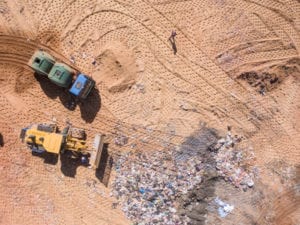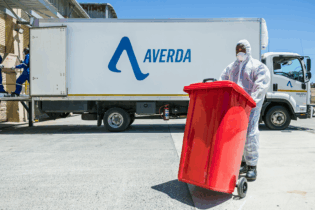Far more than mere dumps, modern landfills are sophisticated facilities integrated into the very landscape itself.
Therefore, they must comply with rigorous waste assessment and management regulations designed to ensure the safety of both the community and the natural environment. When waste management company Averda built their Vlakfontein landfill site near Vereeniging in 2015, they were fully confident that this flagship facility was on a par with the lofty standards set by some of the developed worlds’ most advanced facilities. As such, Averda’s technicians at Vlakfontein closely monitor every aspect of the local environment, from ground water to traffic noise and air quality, taking cognizance of how the landfill affects its surrounds, and proactively encouraging a positive, symbiotic engagement with local communities. Reg Gerber, National Landfill Manager at Averda explains that Vlakfontein, built in the midst of a conservancy, on the ruins of an old brickworks, is an ideal site for a landfill. Gerber added “the natural clay beneath the liners adds a further dimension of safety against ground water pollution. The constructed liners and drainage layers are specially designed to capture and timeously alert us of any pollution potential.” Leachate – the residual moisture and waterborne toxins that may gradually accumulate within the landfill and filter out from landfilled waste under pressure – is an inevitable consequence of landfills since all waste contains some moisture. Modern operations channel this leachate into specially formulated dams or ponds. These dams can sometimes emit an unpleasant odour, especially on hot days and become the culprit for a spate of complaints from neighbours in the area. Conscious of the need to preserve the environment and the relationship that Averda had built up with neighbours within the conservancy these complaints spurred Gerber to put in processes and expertise to address the situation. Gerber points out that one of their first steps was to reduce the surface area of the leachate dam. Once this was completed, the leachate was treated with products, every 3 hours 24/7, that specifically reduce emissions of hydrogen sulphate and ammonia, the two gases most detectable to humans. In addition, nozzles were placed around the dam which spray an odour neutraliser every 90 seconds every hour of the day and night. This ensure that the air remains odour free, irrespective of wind direction.“Fixed electronic sensors are also deployed around the dams to continuously test air-quality and promptly catch any pollution or odour issues. This enables a level of monitoring which goes beyond the requirements of legislative compliance,” he explains.
Gerber added that Averda welcome contact and communication with their neighbours – even complaints – “as we know we need to work together to keep this precious land clean and safe. From our perspective, our neighbours are actually assisting us with monitoring, which we greatly appreciate.” He says that engagement with community stakeholders is now at an all-time high, thanks to recent innovations such as a dedicated WhatsApp line, which make submitting complaints or information very simple, quick, and easy. He explains that the senses of the community members are in fact a crucial tool in identifying air-quality deviations. Once a complaint is received, Averda promptly dispatches a technician equipped with a handheld air-sampling device, or ‘electronic nose’ to test the air. These devices gather air-quality related data such as temperature, pressure, wind, and levels of various gasses “This helps us ascertain whether our site is in fact the source of the odour, and if so, which technical adjustments to implement in order to solve the problem,” says Gerber. Gerber believes that being good neighbours is critical to viability of the environment and Averda. Rudolf Heymans, Chairman of the Mount Ridge Community Committee, commented that at first they were not happy with the construction of a landfill near their homes but over the last three years Averda have shown their commitment to working and help protect the Mount Ridge community. “They listened to our grievances and address every one of them. Through our partnership we finally were able to build a 28km long fence along the nature reserve keeping the wildlife safe and protected,” Heymans commented. “Averda have gone out of their way to be a part of our community and always respond to any complaint with efficacy. They are good neighbours” added Heymans. To demonstrate this, Gerber has introduced open days where community members can raise issues of concern and which provide Averda an opportunity to showcase the benefits of the operation. “These open days have done much to combat the negative stigma which society has about landfills,” he comments. “Vlakfontein represents a massive investment for Averda. Since the beginning, establishing an atmosphere of mutual trust and maintaining harmonious relations with the nearby community has been a cornerstone of our strategy for remaining viable through the decades to come” explains Gerber.







